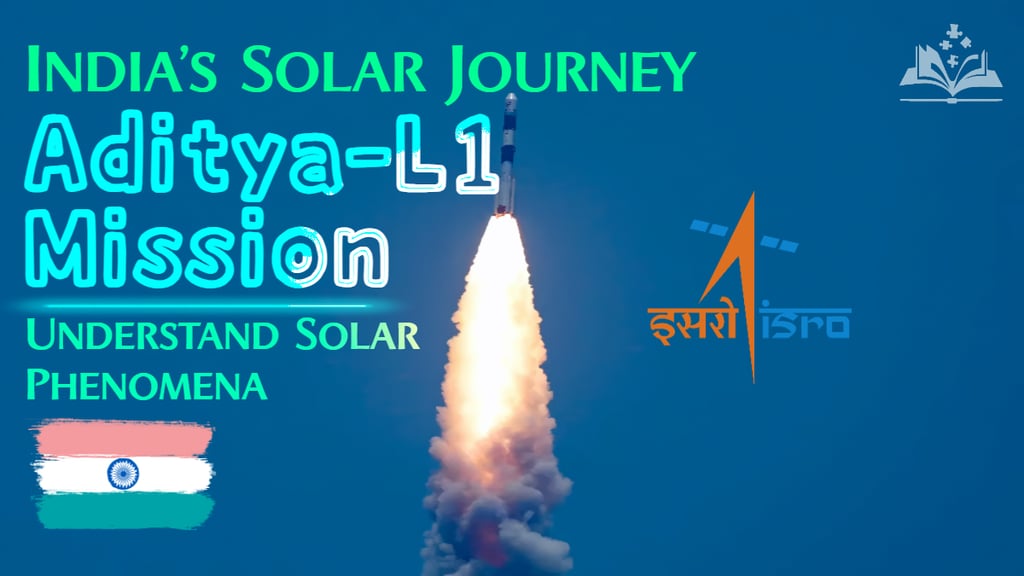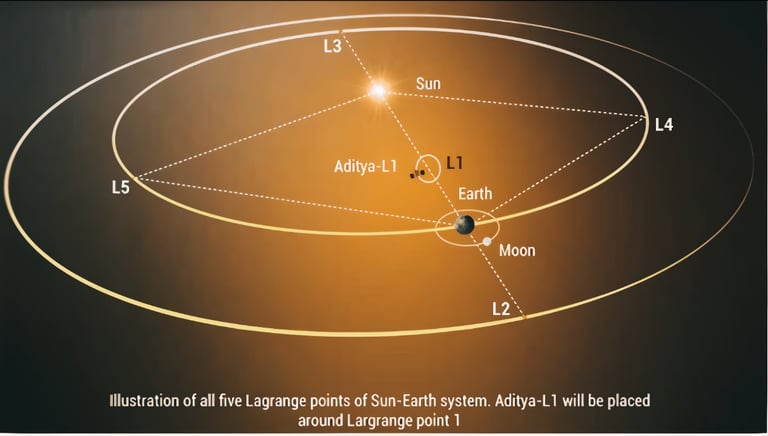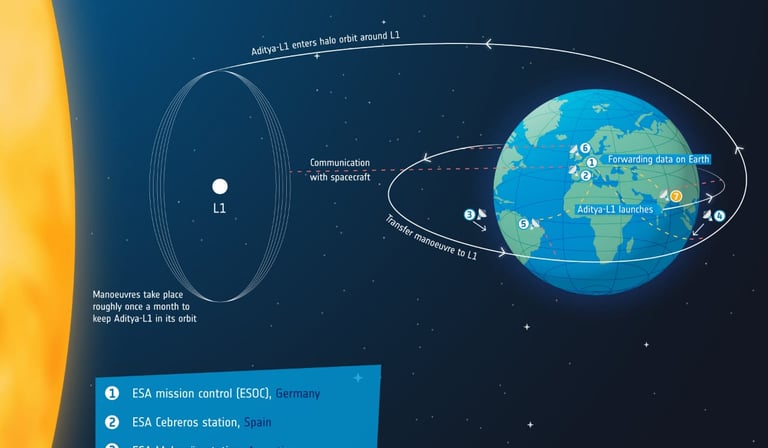
Aditya-L1 Mission: India's Bold Leap Towards Unraveling the Mysteries of the Sun!
Learn about India's Aditya-L1 mission and ISRO's unprecedented effort to study the mysteries of the Sun. Learn how this mission will unravel the mysteries of the solar corona, solar wind and space weather, enhancing our understanding of the Sun's impact on Earth.
SPACE MISSIONISRO/NASASPACE/TECHEDUCATION/KNOWLEDGE
Sachin K Chaurasiya
9/4/20246 min read


Taking a significant step forward for space exploration, India has launched its first mission dedicated to studying the sun with the launch of Aditya-L1. This ambitious project of the Indian Space Research Organisation (ISRO) is a significant milestone in our understanding of solar phenomena and their impact on space weather. But what exactly makes the Aditya-L1 mission remarkable, and why should we care about what is happening 93 million miles away? Let's get to the heart of this unprecedented mission and explore its profound implications.
A Glimpse into the Sun's Secrets!
The Sun is the lifeblood of our solar system, a giant ball of hot plasma whose influence extends far beyond the planets. It shapes the space environment, and its behavior can have significant effects on Earth, especially in the form of solar storms that disrupt communications, navigation systems, and even power grids. The Aditya-L1 mission aims to unravel the mysteries of the Sun, focusing on the solar corona—the outermost layer of the Sun's atmosphere, which is surprisingly hotter than the Sun's surface.
The Genesis of Aditya-L1
The journey of Aditya-L1 began more than a decade ago, with the mission initially designed as a simple satellite to study the solar corona. However, as scientists realized the vital importance of understanding space weather, the scope of the mission grew. What began as a modest project evolved into a sophisticated mission designed to study many aspects of the sun's influence on our solar system.
Why the Solar Corona?
One of the biggest puzzles in solar physics is why the solar corona is hotter than the Sun's surface. The Sun's surface temperature is about 5,500 degrees Celsius, but the corona can reach temperatures of over a million degrees Celsius. Aditya-L1 is equipped to study this mysterious region in unprecedented detail, with the aim of uncovering the mechanisms that heat the corona and drive the solar wind—a stream of charged particles constantly emanating from the Sun.


The Instruments on Aditya-L1: Eyes on the Sun!
The Aditya-L1 mission is equipped with state-of-the-art instruments, each designed to investigate different aspects of solar activity:
Visible Emission Line Coronagraph (VELC): This instrument will block the sun's disk, allowing scientists to study the emissions of the corona without any interference. The VELC will provide information about the processes that heat the corona and trigger the solar wind.
Solar Ultraviolet Imaging Telescope (SUIT): SUIT will capture images of the Sun's photosphere and chromosphere in ultraviolet light. These observations will help us understand variations in the sun's ultraviolet radiation, which affects Earth's atmosphere and climate.
Solar Wind Particle Experiment (ASPEX): ASPEX will analyze the composition, velocity, and density of solar wind particles. This data is important for understanding how the solar wind interacts with Earth's magnetosphere, affecting space weather.
Magnetometer: The magnetometer on Aditya-L1 will measure the strength and direction of magnetic fields at the L1 point, providing crucial information about the Sun's magnetic effect on the space environment.
Journey to the Lagrange Point 1 (L1): The Sweet Spot!
The Aditya-L1 spacecraft is to travel to a special point in space known as Lagrange Point 1 (L1), located about 1.5 million kilometers from Earth. This location provides a unique vantage point from which to make continuous observations of the sun without any interruption from eclipses. The journey to L1 involves a series of carefully calculated orbital maneuvers to gradually raise the spacecraft's orbit before it is captured by the gravitational pull at L1.
What lies ahead: The Mission's Legacy!
As soon as Aditya-L1 settles into its orbit around L1, the instruments will undergo a period of calibration before the scientific phase can begin. The mission is expected to last at least five years, during which it will send back a wealth of data on the sun's activity. This data will not only advance our understanding of solar physics but also improve space weather forecasting models, potentially safeguarding our technological infrastructure from the devastating effects of solar storms.


Why Aditya-L1 Matters: A Global Contribution!
The significance of Aditya-L1 extends beyond India's borders. As one of the few dedicated solar missions globally, it represents a significant contribution to international efforts in space science. Data collected by Aditya-L1 will be shared with the global scientific community, fostering collaboration and pushing the boundaries of our knowledge about our nearest star.
Challenges on the Horizon
Operating a mission like Aditya-L1 is not without challenges. The harsh environment of space, the need for precise control over the spacecraft's orbit, and the continuous operation of highly sensitive instruments all pose significant technical hurdles. However, ISRO's track record and the careful planning behind Aditya-L1 give confidence that these challenges can be overcome.
A Vision for the Future
Aditya-L1 is not just a mission; it is a step towards even more advanced space exploration efforts. By unraveling the mysteries of the Sun, this mission sets the stage for future solar studies and strengthens India's position in the global space community. Moreover, it inspires a new generation of scientists and engineers to push the boundaries of knowledge and exploration.
Launch and Deployment
Launch Date: Aditya-L1 was successfully launched on September 2, 2023, by the Indian Space Research Organization (ISRO) using the Polar Satellite Launch Vehicle (PSLV-C57).
Launch Site: The mission lifted off from the Satish Dhawan Space Centre in Sriharikota, India.
Mission Objective: The primary goal of Aditya-L1 is to study the Sun from Lagrange point 1 (L1), about 1.5 million kilometers from Earth, where the gravitational forces of the Earth and the Sun balance the satellite's orbital motion. This position allows for continuous observation of the Sun without any eclipses or occultations.
Current Status
Orbit Raising Activities: After launch, Aditya-L1 performed a number of orbit-raising activities to gradually increase its orbit around Earth before moving towards the L1 point. These activities are critical to ensuring that the spacecraft is on the right trajectory to reach its destination.
Spacecraft Health: As per the latest reports, the spacecraft is in good health, and all its systems are working as expected. The solar panels have been deployed, and the spacecraft is generating power as planned.
Journey to L1: Aditya-L1 is currently moving towards the L1 point. The journey will take around 125 days, during which the spacecraft will undergo multiple trajectory corrections to accurately reach the L1 point.
Mission Timeline
Calibration Phase: Once Aditya-L1 reaches the L1 point, the spacecraft and its payloads will undergo a calibration phase. During this, the instruments will be tested and fine-tuned to prepare them for scientific observations.
Scientific Observations: The scientific phase of the mission is expected to begin after the calibration period, when the instruments will start collecting data on the solar corona, solar wind, and other solar phenomena.
Scientific Goal
Solar Corona Studies: The mission aims to study the heating of the solar corona, one of the most intriguing aspects of solar physics.
Solar wind analysis: Aditya-L1 will analyze the properties of the solar wind and its interaction with the Earth's magnetic field.
Space weather monitoring: Data obtained from Aditya-L1 will contribute to a better understanding of space weather, which can have a significant impact on satellite communications and power grids on Earth.
Global significance
International collaboration: Data obtained from Aditya-L1 is expected to be shared with the global scientific community, contributing to international efforts in solar research and space weather prediction.
The Aditya-L1 mission is a testament to human curiosity and our relentless pursuit of knowledge. As the spacecraft embarks on its journey to study the Sun, it carries with it hopes of unraveling some of the deepest mysteries of our universe. For India, this mission is a matter of great pride, but for the world, it is a giant leap in our understanding of the Sun and its profound impact on life as we know it.
The Sun may be 93 million miles away, but its impact on Earth is undeniable. With Aditya-L1, we are taking a critical step towards understanding that impact, ensuring that we are better prepared for the challenges posed by our dynamic and ever-changing star.
Subscribe to our newsletter
All © Copyright reserved by Accessible-Learning
| Terms & Conditions
Knowledge is power. Learn with Us. 📚


